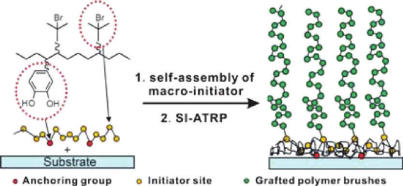Surface-initiated atom transfer radical polymerization (SI-ATRP) provides a facile approach for decorating a variety of planar and colloidal substrates with chemically tethered polymer brushes on one end. The vast majority of reported SI-ATRP usually utilized either silane or thiol small-molecule initiators to initiate polymerization. Although widely employed, the method still has strong limitations because of the inherent properties of initiators. Alternative macroinitiators have been reported to overcome such limitations of small-molecule initiators. However, most of the reported macroinitiators involved polyelectrolyte macroinitiators, which are limited to the modification of cationic or anionic surfaces. Thus, macroinitiators with good stability that can be used to effectively modify divers substrates in a convenient and nondestructive way are still highly desirable.
 |
Researchers at the State Key Laboratory of Solid Lubrication, Lanzhou Institute of Chemical Physics (LICP), Chinese Academy of Sciences (CAS), have synthesized a catechol-containing macroinitiator, which can be used to modify substrates including metals, metallic oxide, polymers, and ceramics with functional polymer brushes via the surface-initiated atomic transfer radical polymerization method. The macroinitiator can be applied to modify both planar substrates and nonplanar geometries and yields a high density polymer films. The macroinitiator is compatible with microcontact printing technology to fabricate patterned polymer brushes. The resulting macroinitiator can combine the advantages of catecholic group with macromolecules to grow good adhesion films under ambient conditions in a convenient and nondestructive way.
The work has received support from the National Natural Science Foundation of China. The findings have been published in Langmuir(Langmuir2012, 28, 2574−2581).
